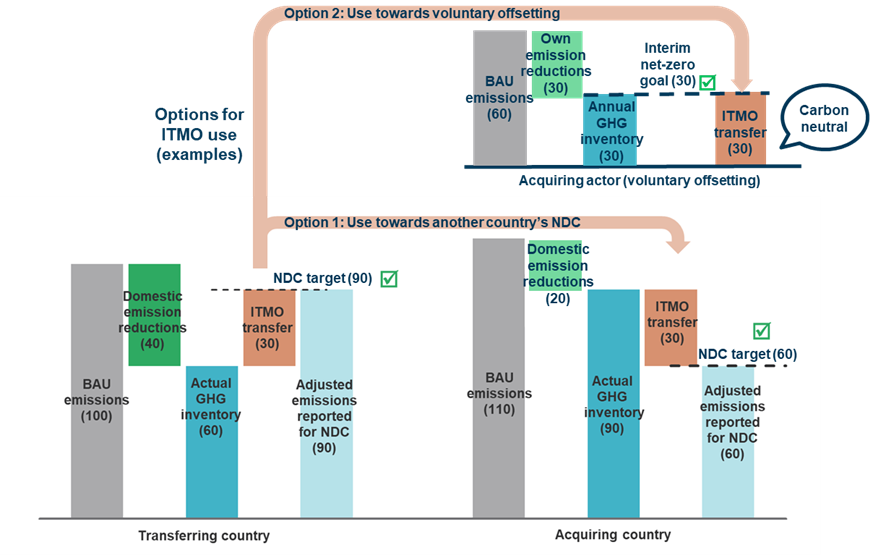A post by Kenneth Möllersten (IVL Swedish Environmental Research Institute), Hanna-Mari Ahonen (Perspectives Climate Research) & Lars Zetterberg (IVL Swedish Environmental Research Institute)
In this blog post, we explain why voluntarily seeking so-called “corresponding adjustments” is not a question of whether the Paris Agreement requires them for voluntary offsetting (it does not). Instead, it is a matter of whether an actor wants to voluntarily help to close the ambition gap to contribute to the global 1.5-degree goal. To get claims about offsetting and carbon neutrality right, a global accounting approach must be applied.
Countries’ existing targets to the Paris Agreement fall critically short of limiting global warming to 1.5 degrees in line with the agreement’s long-term goal. To close this “ambition gap”, the collective global ambition needs to be urgently increased.
Non-state actors have a key role in global mitigation efforts, both in achieving and enhancing national targets, as well as supporting mitigation beyond existing national targets. Non-state actors are increasingly referring to “carbon neutrality” and “net-zero emissions” to portray their climate goals and efforts. These concepts are still evolving, and, though already widely adopted, related goals and achievements remain heterogenous.
Due to the difficulty of reducing all greenhouse gas (GHG) emissions to zero, particularly in the near term, “offsetting” is an often used feature in many carbon neutrality targets. Offsetting refers to the use of “carbon credits” emanating from mitigation outcomes (emission reductions or carbon removals) achieved outside of an actor’s value chain or relevant system boundaries to counterbalance the climate impact of specific emissions, such as the carbon footprint of an actor, activity or product. Carbon neutrality has traditionally been achieved by fully offsetting the carbon footprint.
The draft Nordic Code of Best Practice for Voluntary Compensation of GHG emissions, which was published for consultation in June 2022, synthesises the most ambitious best practices for the voluntary use of carbon credits, including for offsetting (Nordic Dialogue on Voluntary Compensation, 2022). These are highlighted below.
Regarding the role of offsetting, it is widely recognised that offsetting should complement – not substitute – own mitigation by addressing emissions that remain despite ambitious own action. The Nordic Code requires entities to prioritize immediate mitigation of direct and indirect GHG emissions within the scope of their own value chain or organisational boundaries in line with a 1.5-degree compatible mitigation pathway.
While synonymous at the global level, carbon neutrality and net zero are not used as synonyms at the level of non-state actors. Carbon neutrality has traditionally referred to a situation where the GHG emissions attributed to an entity’s operations, products or services have been fully offset by using at least an equivalent amount of carbon credits that are exclusively claimed by the actor, such that the net contribution of the actor’s operations, products or services to global GHG emissions is zero. Net zero, on the other hand, denotes the endpoint when an entity has reduced its own emissions in line with a science-based net-zero pathway and counterbalanced any remaining emissions with removals.
The Nordic Code reflects the emerging consensus that offsetting should be used to exceed – not meet – net-zero pathways and targets. This would mean that offsetting could be used for carbon neutrality claims but not for net zero claims (with the exception of using removal-based carbon credits in the net-zero target year to cover any remaining emissions).
For offsetting to truly counterbalance the climate impact of specific emissions, it needs to be based on real and additional mitigation outcomes that are uniquely claimed for offsetting (Ahonen, Möllersten & Spalding-Fecher, 2021). There is broad agreement that carbon credits should meet quality criteria, e.g., relating to additionality, baselines, permanence, monitoring, verification and environmental and social safeguards, and be issued under recognised, credibly governed crediting standards. Prior to the Paris Agreement, there was broad agreement that voluntary offsetting should be based on mitigation that is not counted towards countries’ targets, meaning carbon credits from countries without targets.
In the Paris Agreement era, all countries have targets. Article 6.2 of the Paris Agreement enables host countries to authorise mitigation outcomes for use towards other countries’ targets, international mitigation purposes or other purposes, such as voluntary offsetting (UNFCCC, 2022). To avoid double claiming, the host country excludes authorised mitigation outcomes from its target by applying so-called corresponding adjustments to its emissions balance (Figure 1). The use of such mitigation outcomes for voluntary offsetting ensures that the offsetting claim is true and accurate and helps to close the global ambition gap.

The Nordic Code includes criteria for high-integrity carbon credits, crediting standards and carbon registries. It differentiates claims associated with the voluntary use of carbon credits based on whether they contribute towards or beyond existing national NDC targets (see Figure 2). Offsetting should only be based on carbon credits that are backed up with mitigation beyond existing NDC targets. Those carbon credits can also be used to make claims about “overall mitigation in global emissions” to contribute to closing the ambition gap without linking it to counterbalancing specific emissions. Carbon credits that represent mitigation towards NDC targets can be used to help countries meet their targets and make related claims about “national mitigation contributions”.

The Nordic Code’s approach promotes “global accounting” to better understand how non-state actors contribute to national targets and closing the ambition gap. It relates the voluntary use of carbon credits to these contributions, and limits offsetting to global ambition-raising beyond existing targets and own, science-aligned action.
References
- Ahonen, H.-M., Möllersten, K. & Spalding-Fecher, R. (2021). Voluntary compensation of greenhouse gas emissions, Copenhagen: Nordic Council of Ministers.
- Nordic Dialogue on Voluntary Compensation (2022). Draft Nordic Code of Best Practice for Voluntary Compensation of Greenhouse Gas Emissions. Perspectives Climate Research; IVL Swedish Environmental Research Institute; Carbon Limits, Tyrsky Consulting.
- Spalding-Fecher, R., Martin, M., Saines, R. & Schneider, L. (2021). Summary Report: Designing governance structures and transactional documentation for mitigation outcome transactions under Article 6 of the Paris Agreement, Seoul: GGGI; SEA.
- UNFCCC (2022). Decision 2/CMA.3: Guidance on cooperative approaches referred to in Article 6, paragraph 2, of the Paris Agreement.
The views and opinions expressed in this post are solely those of the author(s) and do not reflect those of the editors of the blog of the project LIFE DICET.

